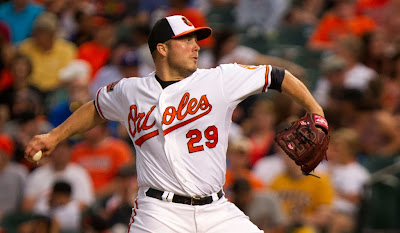Right now, the O's DH situation looks similar to how it was at the beginning of last season. Steve Pearce and Nolan Reimold, who were both tendered contracts this offseason, each started out last season getting an opportunity to DH. But Pearce (44 games) ended up battling wrist injuries for much of the season, and Reimold (40 games) needed neck surgery for a second time. Pearce and Reimold were supposed to handle the right-handed side of that DH platoon; Wilson Betemit was supposed to provide the left-handed pop. But he sustained a right knee injury in March that required surgery, and although he was able to return in late August, he failed to get a hit in 10 at-bats and was soon designated for assignment.
One potential answer to the team's DH issues is to scrap the DH platoon and just sign Kendrys Morales. Here's Roch Kubatko, expressing an opinion that seems to be popular with plenty of fans:
I want a full-time designated hitter - I'm still beating the Kendrys Morales drum - which allows Reimold to serve as an extra outfielder (and occasional DH) and Henry Urrutia to play every day in left field at Triple-A Norfolk. He's raw and needs the reps.I agree on Urrutia. I'm not sure he's ready to handle even a part-time role in the majors just yet, and it would not be bad for him to play every day at Norfolk. But let's explore the Morales possibility a bit further.
 |
| Kendrys Morales (photo via Keith Allison) |
Morales broke his lower left leg celebrating that grand slam, and he missed the rest of the 2010 season. He needed surgery to repair the injury, and about a year later, he opted for a second surgery after he had yet to fully recover. He missed the entire 2011 season as well. But he battled back, and Morales played in 134 games in 2012 and 156 games in 2013, while mainly DHing and playing occasionally at first base. His offensive numbers did not approach that career-best 2009 season, though: He had a wOBA of .339 in 2012 and .342 in 2013.
-----
There are obvious reasons why Morales was listed fourth on Dave Cameron's "Land Mines of the 2014 Free Agent Class" post from November. Besides the injury concerns (fair or unfair) listed above, Morales is not a great defender at first base and can no longer handle a full workload at the position; is a liability on the basepaths (career 34.6 baserunning runs below average); is a good but not great hitter who may be in decline; will likely command a two- or three-year deal; and will cost the team that signs him a draft pick because the Mariners extended him a qualifying offer, which he rejected.
Morales, a switch-hitter, is also not particularly adept at hitting left-handed pitching (.318 wOBA). He is much better against right-handed pitching (.359 wOBA). So, because Morales doesn't bring much to the table besides his bat, the O's could instead choose to find a good bat against right-handed pitching elsewhere. They lost a very good option against lefties when they traded Valencia (.380 wOBA vs. LHP) away, but Pearce (.349 wOBA vs. LHP) is effective against them. Unfortunately, he cannot hit right-handed pitching (.276 wOBA). Reimold has hit about the same against both -- .338 wOBA vs. RHP and .327 wOBA vs. LHP. But he is a wild card and should not be counted on to stay healthy.
Do you view Urrutia as a DH option? I don't, but it's possible. What about bringing back Betemit for cheap? As long as he's healthy, Betemit wears out right-handed pitching (.352 wOBA). The O's could then use that saved money to sign a starter and maybe another reliever. I am a bit surprised the Orioles haven't done more yet in free agency, but that will be something to revisit down the road if they don't spend more to fill some holes on the roster.
So what would you prefer? Morales's .359 wOBA vs. RHP and .318 wOBA vs. LHP, no first-round draft pick, and handing him a decent-sized contract? Or Betemit's .352 wOBA vs. RHP and Pearce's .349 wOBA vs. LHP? Betemit is not an option at third base (and maybe not even first base) and can't hit lefties, so he would limit roster flexibility. But he would only receive a one-year deal, and he wouldn't cost a draft pick. Morales is still probably the better option.
Relying on Pearce, Reimold, Betemit, or any other platoonable bat at DH is risky. They are all injury risks, and it's not like there are many other good options at this stage of free agency to bring aboard as competent bench bats. But Morales is far from a sure thing, and while he'd make the O's somewhat better right now, he's also an injury risk, isn't quite as good as fans think, would cost the team a draft pick, and is a more expensive option. I wouldn't be surprised at all if the O's eventually signed him, but I'm not sure they should.



